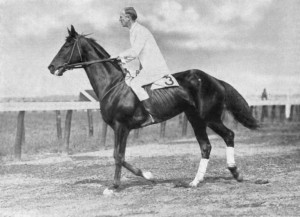 George Patton, the general who led the U. S. Army through the “Battle of the Bulge” in World War II, was a master of the saber and a fine rider. He represented the United States at the 1912 Olympics in the pentathlon competition, which tested the abilities needed by the ideal soldier: swimming, running, shooting, fencing (saber), and riding (show jumping). Patton finished fifth overall and excelled in the saber bout, where he defeated the French world champion.
George Patton, the general who led the U. S. Army through the “Battle of the Bulge” in World War II, was a master of the saber and a fine rider. He represented the United States at the 1912 Olympics in the pentathlon competition, which tested the abilities needed by the ideal soldier: swimming, running, shooting, fencing (saber), and riding (show jumping). Patton finished fifth overall and excelled in the saber bout, where he defeated the French world champion.
The saber was the traditional weapon of the cavalry officer. He carried his reins in his left hand and slashed at the enemy with the saber in his right hand. In fencing competitions nowadays, saber fencers wear metal masks and metallic gloves and vests; “touches” are scored electronically. But the saber “lamé” vest only goes to the waist. Touches below the waist do not count. The reason is military and historical and equine: slashing “below the waist,” and risking hurting another officer’s horse, was cowardly and wasteful.
After the Olympics Patton trained in saber at the French Cavalry School in Saumur. He returned to the States and became an instructor at Fort Riley, Kansas. His saber skills earned him the title “Master of the Sword.” He re-designed the Army saber (the first alteration since 1861), giving it a straight, two-edged blade, more suitable for a cavalry charge.
He was an expert at one of the most difficult cavalry exercises: standing in the stirrups at full gallop, reins in left hand, saber pointed straight ahead with a straight arm…and spearing a dangling brass ring with the tip of the saber.
Patton, born too late, missed using his skills in great cavalry charges and battles. In fact, he participated in the first motorized attack in U. S. Army history—the raid against Pancho Villa in 1916. (The “motors” of this attack were three 1915 Dodge touring cars.) By 1918 Patton was an expert in tank warfare and had commanded tank brigades with the U. S. Army in Europe.
In between the two World Wars, the industrialized nations started replacing horse cavalry with tanks. Patton was an early advocate of mechanized warfare. Before the attack on Pearl Harbor, Patton distinguished himself during war games and came to the attention of General Dwight D. Eisenhower, who would soon be the commander of Allied forces in Europe. Patton led the 7th and, later, the 3rd U. S. Army through North Africa, Italy, France, and into Germany.
Alois Podhajsky, head of the Spanish Riding School in Vienna, where dressage was practiced in its purest form, asked Patton to protect the Lipizzan horses. Podhajsky feared that the Germans would use the horses for pulling artillery and that refugees would slaughter and eat the rest. After seeing a performance of “high school” dressage, Patton agreed, and the U. S. Army began protecting the stallions in Vienna. The Germans, however, had taken the mares from the Austrian breeding operation and had moved them to Czechoslovakia. The Russian Army overran that country as they pushed towards Berlin. Captured German officers, who loved horses and who feared Russians more than Americans, begged Patton to step in. Patton authorized a risky but successful foray into the Russian-held territory to liberate the mares. (The story of Patton and the Lipizzans is told in the Disney movie Miracle of the White Stallions.)
Patton’s style as a general was forged in the cavalry tradition: he liked to move fast and attack hard. He saw tanks as the modern equivalent of horse troops, because tanks can conquer rough ground with speed, penetrate enemy lines, and frighten infantry. But Patton was a realist: he knew that the machine gun and improved artillery accuracy could stop a cavalry charge dead. It is possible that Patton worked hard to make Army horses obsolete because he had seen the horrible suffering of horses during World War I. It is also possible that he, a horseman, believed that sending horses to war was unethical.






General Patton saved the Lipizzan and Andalusian horses in WW2 and the world is better for it! They’re so special, athletic and beautiful.